Premenstrual Syndrome Treatment Market Size
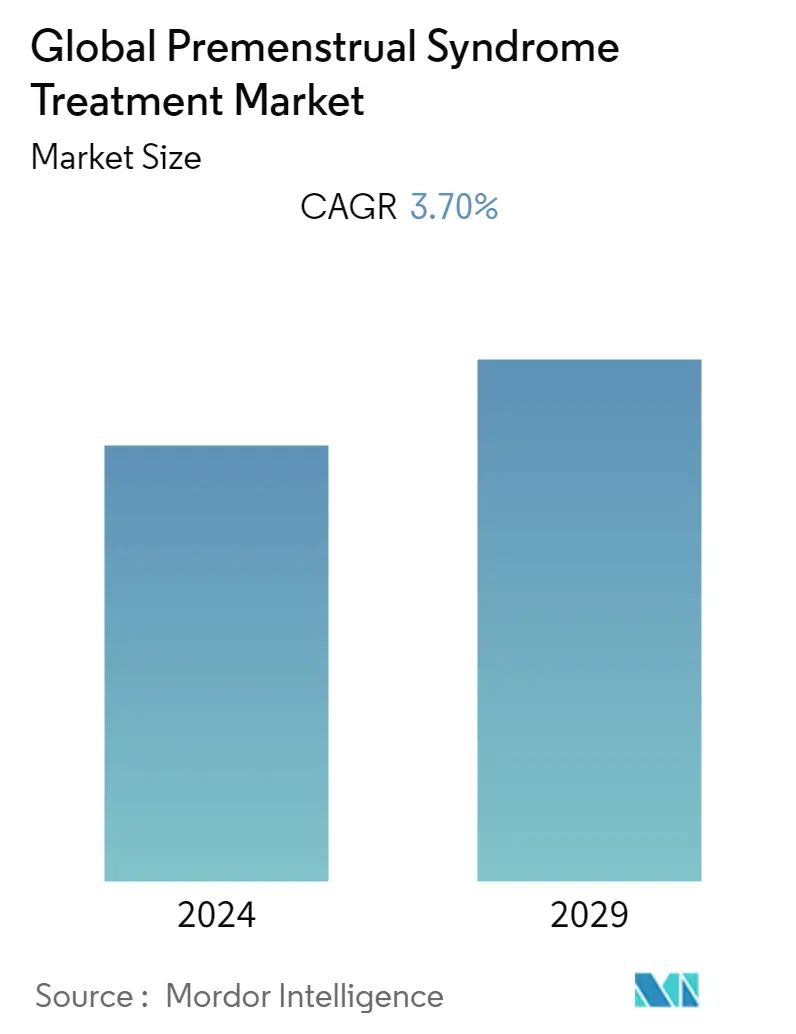
| Study Period | 2019 - 2029 |
| Base Year For Estimation | 2023 |
| CAGR | 3.70 % |
| Fastest Growing Market | Asia-Pacific |
| Largest Market | North America |
| Market Concentration | Medium |
Major Players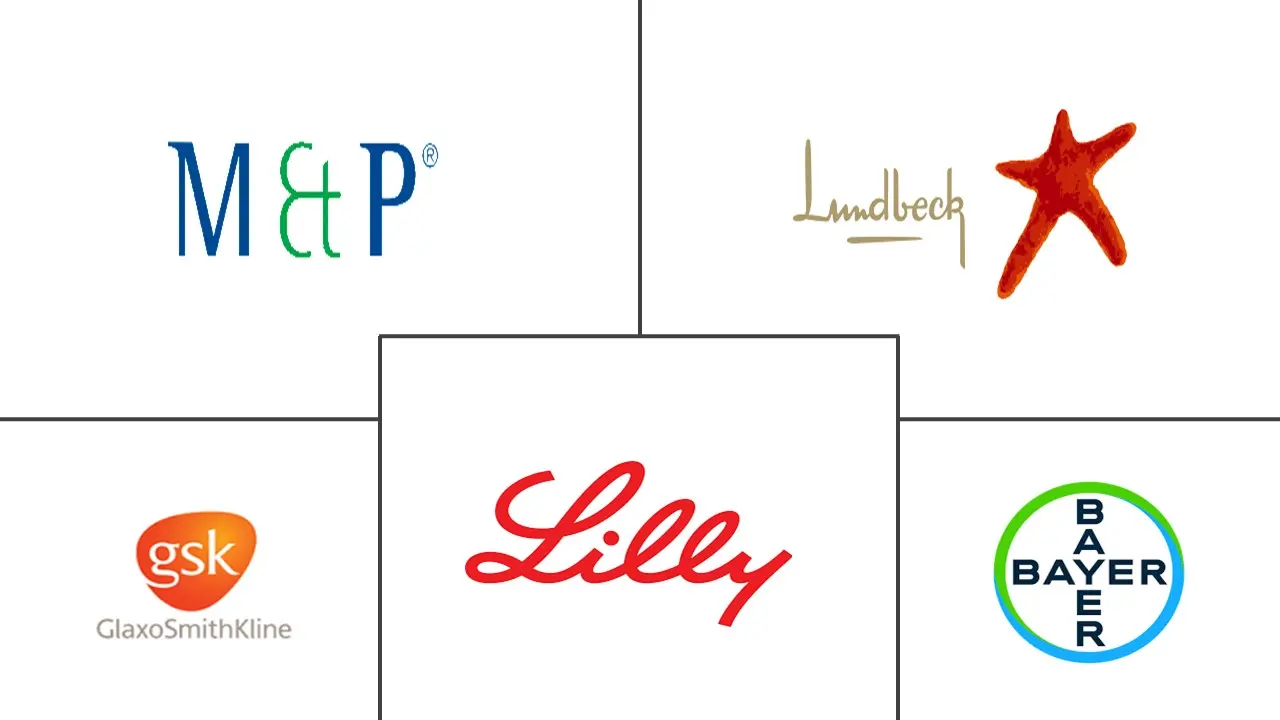
*Disclaimer: Major Players sorted in no particular order |
Premenstrual Syndrome Treatment Market Analysis
The global premenstrual syndrome treatment market is expected to grow with an estimated CAGR of 3.7%, over the forecasts period.
Amid pandemic, limited transportation was created impediments for international trade and transportation. As a result, disrupted the supply of women's healthcare medicine and temporarily leading to falling in demand due to uncertainty in the global economy. Panicked buying of women's healthcare and hygienic product depleted the supply and thereby shortfall increased. Thus, COVID-19 has moderately impacted the premenstrual syndrome treatment market. According to the study conducted by the Cheng Organization in the year 2020, published in Menstrual Health Alliance of India (MHAI), there were 62% of respondents facing challenges to access women's healthcare products during covid-19. In 2020, MHAI estimated that in India 336 million women were menstruating of which 221 million women accessed menstrual healthcare products.
The factors that are driving the market growth include increasing awareness regarding the diagnosis and treatment of premenstrual syndrome, a higher number of the target population, a rise in demand for PMS drugs, and easy availability of drugs. Premenstrual syndrome affects almost three out of every four women at some point in their lives. According to a study published in the General Psychiatry Journal, in 2020, 90% of women of reproductive age experience a variety of premenstrual symptoms ranging from mild to severe. Premenstrual Syndrome affects 20-40% of all women. As a result, the demand for premenstrual syndrome treatment is increasing thereby boosting the overall market growth.
Furthermore, to raise knowledge of menstrual health among women, both government and non-government organizations have launched awareness campaigns. In 2018, in Japan, the 'LADY' program was launched by JOICFP, a Japanese non-governmental organization, the LADY program strives to achieve universal access to premenstrual and reproductive health services, rights, and information including maternal health and family planning for women and girls around the world. Similarly, the United States Department of Health and Human Services' Office of Women's Health (OWH) is involved in raising awareness by addressing women's health issues on menstruation, menstrual hygiene, premenstrual syndrome as well as its complication, and pregnancy.
In addition, campaigns from government and non-government organizations to elevate female health status and education support the market growth. For instance, according to the report published in the National Health Institute, 2020, the prevalence of PMS had been reported in 20 to 32% of premenopausal and 30-40% of the reproductive female population. According to an article published in 2019, in the Journal of Obstetrics and Gynaecology reported that 4 out of 10 women have premenstrual symptoms and 5-8% of them were severely affected by PMS. In addition, PMS was seen in France at the lowest rate (12%) and Iran at the highest rate (98%). PMS is also very common in every country and especially women in the young age group are reported to have a high rate (66%-91.8%) of PMS. Hence as the rate of PMS increases the demand for the treatment increases thus, drive the growth of the market studied.
However, side-effects associated with therapies for premenstrual syndrome restraint the market growth.
Premenstrual Syndrome Treatment Market Trends
This section covers the major market trends shaping the Premenstrual Syndrome Treatment Market according to our research experts:
Analgesic Drug Segment is Expected to Show Significant Growth During the Forecasts Period
Analgesics, also known as painkillers or pain relievers, are drugs that help in relieving pain without affecting consciousness, altering sensory perception, or blocking nerve impulse conduction. These analgesics are generally used to reduce PMS symptoms such as stomach cramps, headache, muscle pain, joint pain, and others. According to a study published in the National Health Institute in 2020, among all the analgesics used for the treatment of Premenstrual syndrome, diclofenac was the most commonly used analgesic followed by ibuprofen, ketoprofen, naproxen, aspirin, and placebo. As analgesics are the most effective treatment in premenstrual treatment, it is expected to drive market growth.
According to the article published in National Health Institute 2021, Analgesic is used in the treatment of PMS, including nonsteroidal anti-inflammatory drugs (NSAIDs) such as acetylsalicylic acid and ibuprofen. NSAIDs reduce inflammation, relieve pain, and block the production of prostaglandin. Similarly, according to the report published in the United States Library of Medicine in 2020, 45 % of women worldwide were self-medicated and taking analgesics to relieve the pain associated with premenstrual syndrome.
A large number of women are affected by premenstrual syndrome and cannot afford to reach a hospital to check up on every month and need the analgesics products quickly raise the demand for this segment. Furthermore, most women are preferring self-medication without consulting a doctor. As the demand for this segment grows, market participants in the segment tend to focus more on the launch of new products. For example, in 2020, Bayer launched Midol, a multi-symptom pain reliever analgesic. Because of the rising prevalence of PMS, as well as the affordability and availability of analgesics, the market is expected to grow rapidly during the forecast period.
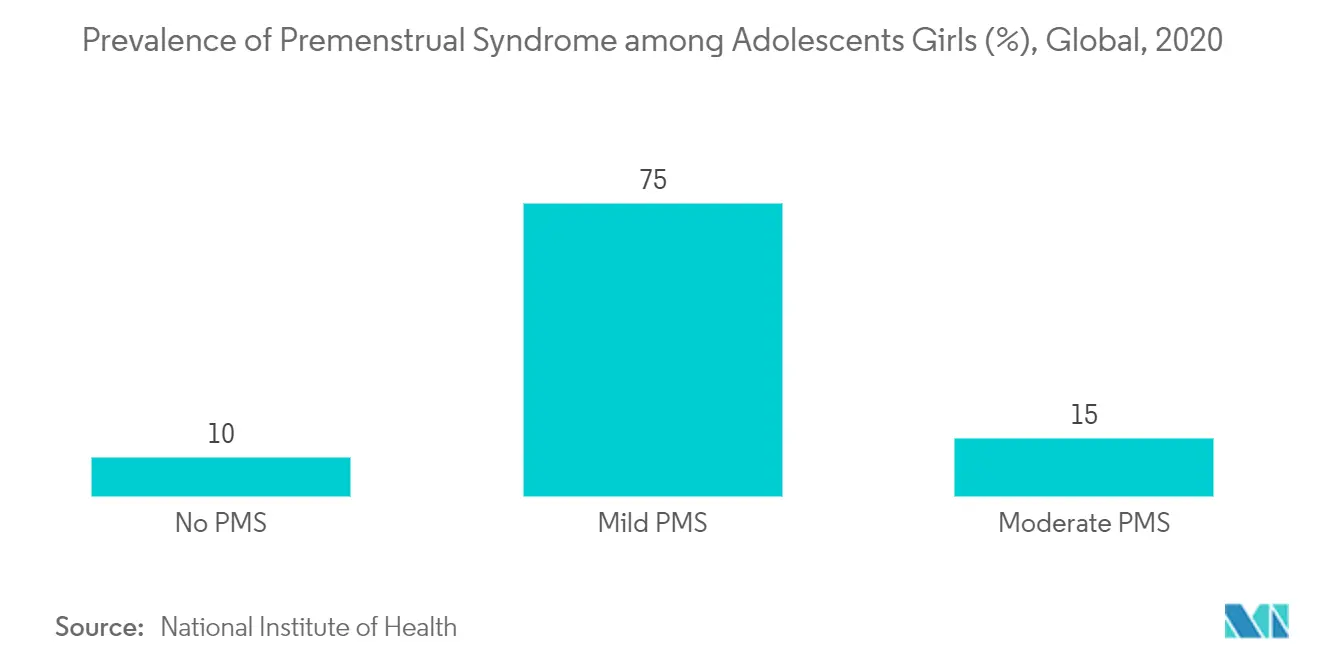
North America is Expected to Hold a Significant Share in the Market and Expected to do Same in the Forecasts Period
North America is expected to hold a major market share in the global premenstrual syndrome treatment market due to an increase in the prevalence and awareness of premenstrual syndrome in females in this region. Hence, the incidence of treatment is also predicted to be high. For instance, a study published in the Indian Journal of Research in 2020, in the United States 2 billion dollars or 600 million working hours lost yearly due to the symptoms of Premenstrual syndrome. According to the Women's Health Concern and British Menopause Society in 2020, about 80% of reproductive women experience premenstrual syndrome pain at some stage in their lifetime. Most women experience some discomfort during pre-menstruation, especially one week before. But in 5%-10% of women, the pain is severe enough to disrupt their life.
Additionally, rising approval is also likely to fuel the market growth as in March 2019, Brexanolone was approved in the United States for the treatment of postpartum depression (PPD) a complication associated with premenstrual syndrome, the first drug approved by the United States Food and Drug Administration (FDA) specifically for PPD in adult women. Furthermore, increasing the approval of premenstrual syndrome therapy and increasing research and development activity for developing innovative drugs and well-established healthcare infrastructure is also fuelling the overall North American market to great extent.
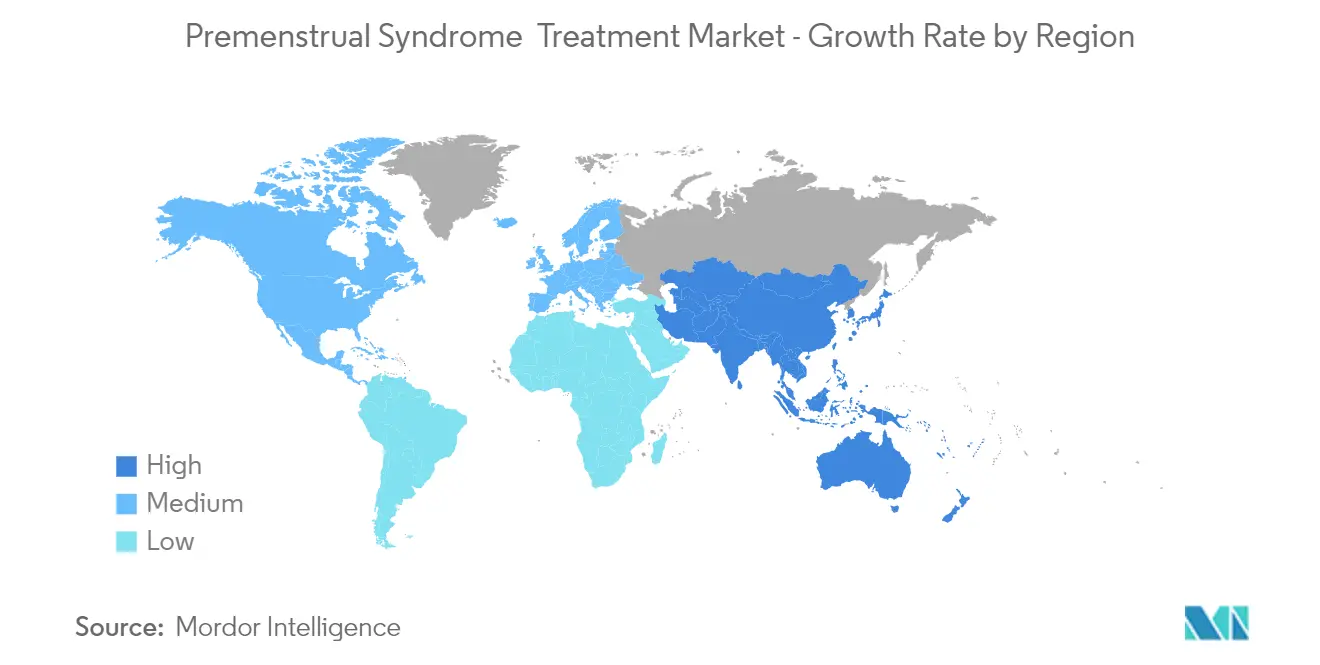
Premenstrual Syndrome Treatment Industry Overview
The premenstrual syndrome treatment market is moderately competitive, with several players across the globe. Few big firms currently dominate the market in terms of market share. The companies are raising investment and funding for the development of therapies for the treatment of Premenstrual Syndrome. Bayer AG, Eli Lilly and Company, GlaxoSmithKline Plc, Pfizer Inc., H. Lundbeck A/S are the leading market players with significant market share.
Premenstrual Syndrome Treatment Market Leaders
-
Eli Lilly and Company
-
GlaxoSmithKline Plc
-
H. Lundbeck A/S
-
MetP Pharma AG
-
Bayer AG
*Disclaimer: Major Players sorted in no particular order
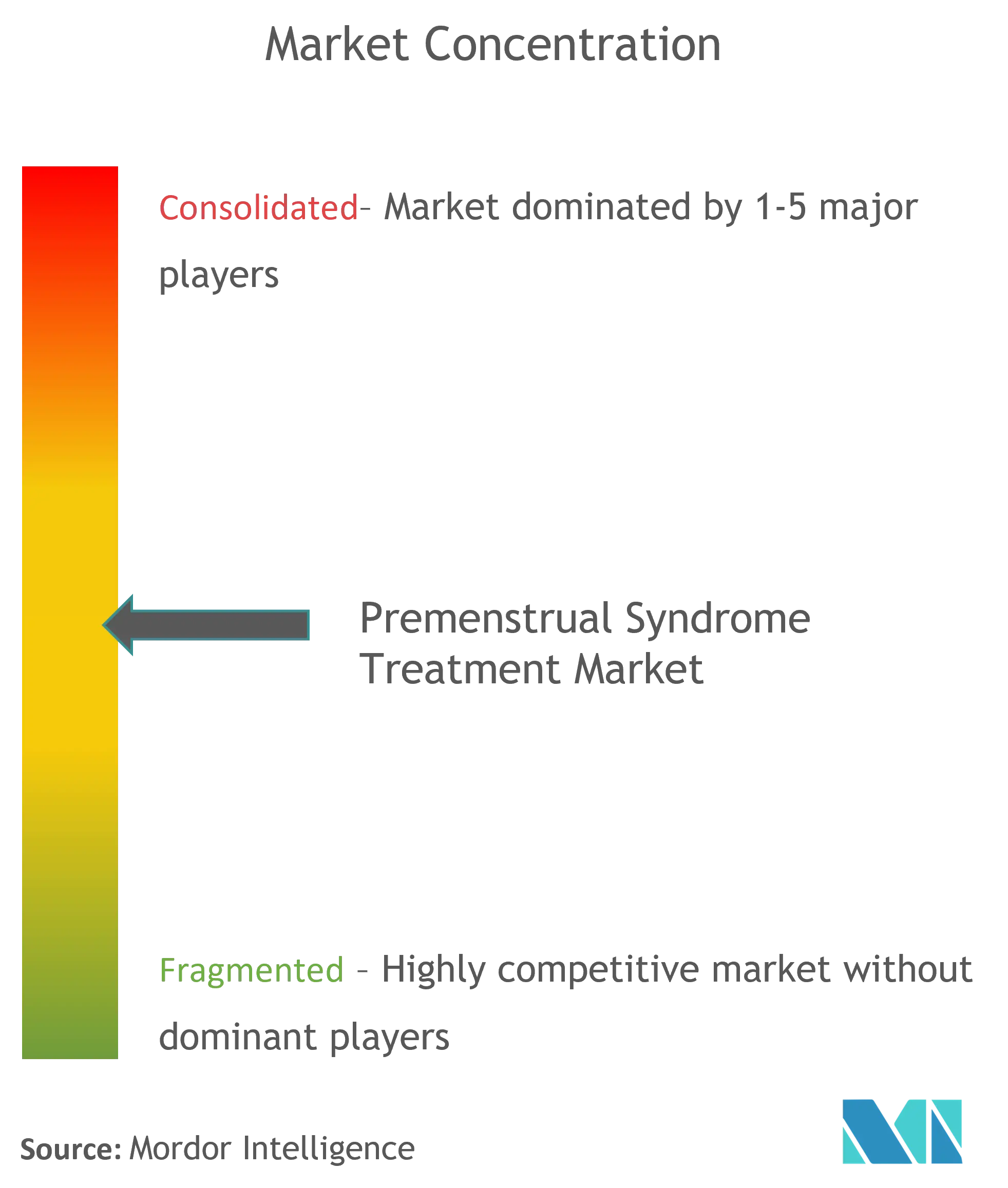
Premenstrual Syndrome Treatment Market News
- In May 2020, AbbVie in cooperation with Neurocrine Biosciences, Inc. recieved United States Food and Drug Administration (FDA) approval for ORIAHN (elagolix, estradiol, and norethindrone acetate capsules; elagolix capsules). ORIAHNN is the first FDA-approved non-surgical, oral medication option for the management of heavy menstrual bleeding associated with uterine fibroids in premenopausal women.
- In March 2019, Sage therapeutics recieved Food and Drug Administration approval for the drug Zulresso injection, for the treatment of postpartum depression (PPD) in adult women the first drug approved by the FDA specifically for Postpartum depression.
Premenstrual Syndrome Treatment Market Report - Table of Contents
1. INTRODUCTION
- 1.1 Study Assumptions and Market Definition
- 1.2 Scope of the Study
2. RESEARCH METHODOLOGY
3. EXECUTIVE SUMMARY
4. MARKET DYNAMICS
- 4.1 Market Overview
-
4.2 Market Drivers
- 4.2.1 Growing Awareness About Premenstrual Syndrome
- 4.2.2 Increasing Burden of Premenstrual Syndrome
-
4.3 Market Restraints
- 4.3.1 Side-Effects Associated With Premenstrual Syndrome Therapies
-
4.4 Porter's Five Force Analysis
- 4.4.1 Threat of New Entrants
- 4.4.2 Bargaining Power of Buyers/Consumers
- 4.4.3 Bargaining Power of Suppliers
- 4.4.4 Threat of Substitute Products
- 4.4.5 Intensity of Competitive Rivalry
5. MARKET SEGMENTATION
-
5.1 By Drug Types
- 5.1.1 Analgesics
- 5.1.2 Antidepressant
- 5.1.3 Oral Contraceptives
- 5.1.4 Gonadotropin-Releasing Harmone (GnRH) Analogues
- 5.1.5 Selective Serotonin Reuptake Inhibitor (SSRI)
- 5.1.6 Others
-
5.2 By Product Types
- 5.2.1 Prescription
- 5.2.2 OTC
-
5.3 By Distribution Channels
- 5.3.1 Hospital Pharmacies
- 5.3.2 Drug Store and Retail Pharmacies
- 5.3.3 E-commerce
-
5.4 Geography
- 5.4.1 North America
- 5.4.1.1 United States
- 5.4.1.2 Canada
- 5.4.1.3 Mexico
- 5.4.2 Europe
- 5.4.2.1 Germany
- 5.4.2.2 United Kingdom
- 5.4.2.3 France
- 5.4.2.4 Italy
- 5.4.2.5 Spain
- 5.4.2.6 Rest of Europe
- 5.4.3 Asia-Pacific
- 5.4.3.1 China
- 5.4.3.2 Japan
- 5.4.3.3 India
- 5.4.3.4 Australia
- 5.4.3.5 South Korea
- 5.4.3.6 Rest of Asia-Pacific
- 5.4.4 Rest of the World
6. COMPETITIVE LANDSCAPE
-
6.1 Company Profiles
- 6.1.1 Bayer AG
- 6.1.2 Eli Lilly And Company
- 6.1.3 GlaxoSmithKline
- 6.1.4 H. Lundbeck A/S
- 6.1.5 Pfizer Inc
- 6.1.6 Asarina Pharma AB
- 6.1.7 Chattem Inc (Sanofi)
- 6.1.8 Dekk-Tec
- 6.1.9 Pherin Pharmaceuticals
- 6.1.10 Novartis International AG
- 6.1.11 Umecrine Mood AB
- 6.1.12 MetP Pharma AG
- *List Not Exhaustive
7. MARKET OPPORTUNITIES AND FUTURE TRENDS
** Subject To AvailablityPremenstrual Syndrome Treatment Industry Segmentation
Premenstrual syndrome (PMS) is a constellation of physical and psychological symptoms that start during the luteal phase of the menstrual cycle or 1 to 2 weeks before the onset of menses. Once these symptoms of PMS become severe, patients are diagnosed with the premenstrual dysphoric disorder (PMDD). Premenstrual Syndrome Treatment Market is segmented by Drug Type (Analgesics, Antidepressant, Oral Contraceptive, Ovarian Suppression Agents, Gonadotropin-Releasing Hormone (GnRH) Analogues, Selective Serotonin Reuptake Inhibitors (SSRIs), and Others), Product Type (Prescription and OTC), Distribution Channel (Hospital Pharmacies, Drug Store and Retail Pharmacies, E-commerce), Geography (North America, Europe, Asia-Pacific, and Rest of the World). The report offers the value (in USD million) for the above segments.
| By Drug Types | Analgesics | |
| Antidepressant | ||
| Oral Contraceptives | ||
| Gonadotropin-Releasing Harmone (GnRH) Analogues | ||
| Selective Serotonin Reuptake Inhibitor (SSRI) | ||
| Others | ||
| By Product Types | Prescription | |
| OTC | ||
| By Distribution Channels | Hospital Pharmacies | |
| Drug Store and Retail Pharmacies | ||
| E-commerce | ||
| Geography | North America | United States |
| Canada | ||
| Mexico | ||
| Geography | Europe | Germany |
| United Kingdom | ||
| France | ||
| Italy | ||
| Spain | ||
| Rest of Europe | ||
| Geography | Asia-Pacific | China |
| Japan | ||
| India | ||
| Australia | ||
| South Korea | ||
| Rest of Asia-Pacific | ||
| Geography | Rest of the World |
Premenstrual Syndrome Treatment Market Research FAQs
What is the current Global Premenstrual Syndrome Treatment Market size?
The Global Premenstrual Syndrome Treatment Market is projected to register a CAGR of 3.70% during the forecast period (2024-2029)
Who are the key players in Global Premenstrual Syndrome Treatment Market?
Eli Lilly and Company, GlaxoSmithKline Plc, H. Lundbeck A/S , MetP Pharma AG and Bayer AG are the major companies operating in the Global Premenstrual Syndrome Treatment Market.
Which is the fastest growing region in Global Premenstrual Syndrome Treatment Market?
Asia-Pacific is estimated to grow at the highest CAGR over the forecast period (2024-2029).
Which region has the biggest share in Global Premenstrual Syndrome Treatment Market?
In 2024, the North America accounts for the largest market share in Global Premenstrual Syndrome Treatment Market.
What years does this Global Premenstrual Syndrome Treatment Market cover?
The report covers the Global Premenstrual Syndrome Treatment Market historical market size for years: 2019, 2020, 2021, 2022 and 2023. The report also forecasts the Global Premenstrual Syndrome Treatment Market size for years: 2024, 2025, 2026, 2027, 2028 and 2029.
Global Premenstrual Syndrome Treatment Industry Report
Statistics for the 2024 Global Premenstrual Syndrome Treatment market share, size and revenue growth rate, created by Mordor Intelligence™ Industry Reports. Global Premenstrual Syndrome Treatment analysis includes a market forecast outlook to 2029 and historical overview. Get a sample of this industry analysis as a free report PDF download.



